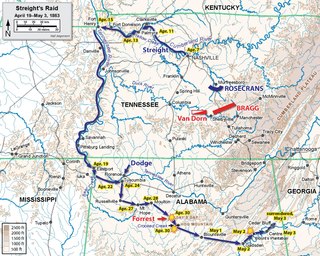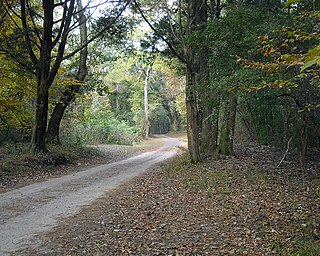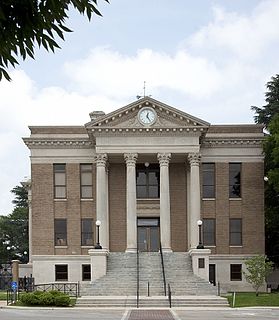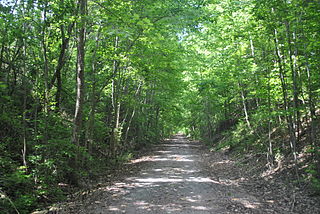
The Battle of Day's Gap, fought on April 30, 1863, was the first in a series of American Civil War skirmishes in Cullman County, Alabama, that lasted until May 2, known as Streight's Raid. Commanding the Union forces was Col. Abel Streight; Brig. Gen. Nathan Bedford Forrest led the Confederate forces.

The Battle of Fort Blakeley took place from April 2 to April 9, 1865, in Baldwin County, Alabama, about 6 miles (9.7 km) north of Spanish Fort, AL, as part of the Mobile Campaign of the American Civil War. At the time, Blakeley, Alabama had been the county seat of Baldwin County.
The Battle of Dry Wood Creek, also known as the Battle of the Mules, was fought on September 2, 1861, in Vernon County, Missouri, during the American Civil War. After his victory at the Battle of Wilson's Creek on August 10, Sterling Price and the Missouri State Guard moved further north into Missouri. A force of Union troops under James H. Lane moved from Fort Scott, Kansas to attempt an interception of Price's army, and set an ambush along Dry Wood Creek. Price's Missouri State Guard troops outnumbered Lane's Kansas troops, and after a two hour skirmish forced Lane to retreat to Fort Scott. In their retreat, Lane's troops abandoned their supplies and mules to the Missourians. Price followed up his victory by continuing his northward march, culminating in another victory at the siege of Lexington, September 13 to 20, before returning south shortly afterwards.
The Battle of West Point, Georgia, formed part of the Union campaign through Alabama and Georgia, known as Wilson's Raid, in the final full month of the American Civil War.

Streight's Raid took place in northern Alabama during the American Civil War. It was led by Union Army Col. Abel Streight and opposed by Confederate Brig. Gen. Nathan Bedford Forrest. Streight's goal was to destroy parts of the Western and Atlantic Railroad, which was supplying the Confederate Army of Tennessee. The raid was poorly supplied and planned, and ended with the defeat of Streight and his 1,700 men at Cedar Bluff, Alabama, by Forrest who bluffed his opponent into surrendering to his 500 men. Streight was additionally hindered by locals throughout his march, while pursued by Forrest, who had the advantage of home territory and the sympathy and aid of the local populace, most famously Emma Sansom.
Wilson's Raid was a cavalry operation through Alabama and Georgia in March–April 1865, late in the American Civil War. Brig. Gen. James H. Wilson led his Union Army Cavalry Corps to destroy Southern manufacturing facilities and was opposed unsuccessfully by a much smaller force under Confederate Lt. Gen. Nathan Bedford Forrest.

Florida participated in the American Civil War as a member of the Confederate States of America. It had been admitted to the United States as a slave state in 1845. In January 1861, Florida became the third Southern state to secede from the Union after the November 1860 presidential election victory of Abraham Lincoln. It was one of the initial seven slave states which formed the Confederacy on February 8, 1861, in advance of the American Civil War.

Alabama was central to the Civil War, with the secession convention at Montgomery, birthplace of the Confederacy, inviting other states to form a Southern Republic, during January–March 1861, and develop constitutions to legally run their own affairs. The 1861 Alabama Constitution granted citizenship to current U.S. residents, but prohibited import duties (tariffs) on foreign goods, limited a standing military, and as a final issue, opposed emancipation by any nation, but urged protection of African slaves, with trial by jury, and reserved the power to regulate or prohibit the African slave trade. The secession convention invited all slaveholding states to secede, but only 7 Cotton States of the Lower South formed the Confederacy with Alabama, while the majority of slave states were in the Union. Congress voted to protect the institution of slavery by passing the Corwin Amendment on March 4, 1861, but it was never ratified.

The 1st Kentucky Artillery was an artillery battery that was a member of the Orphan Brigade in the Confederate States Army during the American Civil War. It fought in several engagements throughout the Western Theater, including the battles of Shiloh, Baton Rouge, Siege of Jackson, Sulphur Trestle, Resaca, Murfreesboro, Jonesborough, Chickamauga, Missionary Ridge, and Johnsonville. Following the end of the Atlanta Campaign, Cobb's Battery was detached from the Orphan Brigade and reassigned to defend Mobile, Alabama.

Fort Anderson, in Paducah, Kentucky was the site of the Battle of Paducah.

During the American Civil War, Arkansas was a Confederate state, though it had initially voted to remain in the Union. Following the capture of Fort Sumter in April 1861, Abraham Lincoln called for troops from every Union state to put down the rebellion, and Arkansas and several other states seceded. For the rest of the civil war, Arkansas played a major role in controlling the Mississippi River, a major waterway.

Historic Blakeley State Park is a park located on the site of the former town of Blakeley in Baldwin County, Alabama on the Tensaw River delta. The park encompasses an area once occupied by settlers in what was a thriving community on the river. Later, Confederate soldiers were garrisoned here and fought in the last major battle of the U.S. Civil War against Union forces.
Signal Knob is the northern peak of Massanutten Mountain in the Ridge and Valley Appalachians with an elevation of 2,106 feet (642 m). It is located in George Washington National Forest in Shenandoah County and Warren County in Virginia.
The 3rd Tennessee Cavalry Regiment was a cavalry regiment that served in the Union Army during the American Civil War.

Confederate Reunion Grounds is a Texas historic site located near Mexia, Limestone County, Texas at the confluence of the Navasota River and Jack's Creek. From 1889–1946, Confederate Civil War veterans and families reunited at the site during late-July or early-August, camping under the giant bur oaks, enjoying speeches, concerts, dances, fellowship and food, and raising funds for families of their fallen comrades.
The Richard Martin Trail or the Richard Martin Rails-to-Trail is a multi-use rail trail open to hikers, walkers, runners, and bicycle and horseback riders in Limestone County, Alabama built on an abandoned rail corridor as part of the Rails-to-Trails Conservancy. The 10.2-mile trail winds through wetlands, the Civil War site Battle of Sulphur Creek Trestle and downtown Elkmont, Alabama. It was named in honor of Richard Martin, local citizen and trail supporter, who led the effort to build the trail for 25 years.
The Civil War Trust's Civil War Discovery Trail is a heritage tourism program that links more than 600 U.S. Civil War sites in more than 30 states. The program is one of the White House Millennium Council's sixteen flagship National Millennium Trails. Sites on the trail include battlefields, museums, historic sites, forts and cemeteries.

The Athens Courthouse Square Commercial Historic District is a historic district in Athens, Alabama. Athens was founded in 1818 when Robert Beaty and John D. Carroll began selling tracts of land. The following year, the town was chosen as the county seat of the newly formed Limestone County. Commercial development around the courthouse square was swift, aided by the strong cotton market. The town and courthouse suffered heavy damage during the Civil War in the Battle of Sulphur Creek Trestle. Athens' revival was slowed by major fires in 1882, 1894, and 1897, as well as the Panic of 1893. Redevelopment was spurred again in the 1910s and 1920s by a diversified economy with increased manufacturing, and in the 1930s by electricity provided by the Tennessee Valley Authority. Notable buildings in the district are the Limestone County Courthouse, built in 1919 in Neoclassical style with Palladian influences. The Old Post Office building was completed in 1933. The district was listed on the National Register of Historic Places in 1997 and the Alabama Register of Landmarks and Heritage in 2012.

The Sulphur Trestle Fort Site is a historic Civil War battle site near Elkmont, Alabama. The fort was the site of the Battle of Sulphur Creek Trestle on September 25, 1864. After defeating Union Army forces and recapturing Athens, Alabama, Confederate General Nathan Bedford Forrest moved north to attempt to destroy a key railroad trestle. The trestle was defended by a fortification manned by 1000 Union soldiers. Forrest's troops easily defeated the Union forces and burned the trestle. Today, about 400 yards of trenches dug around the outside of the fort's parapet remain. The site was listed on the National Register of Historic Places in 1973.












